CBC blood test
A complete blood count (CBC) test measures the following:
- The number of white blood cells (WBC count)
WBC count
A WBC count is a blood test to measure the number of white blood cells (WBCs) in the blood. It is a part of a complete blood count (CBC). WBCs are a...
 ImageRead Article Now Book Mark Article
ImageRead Article Now Book Mark Article - The number of red blood cells (RBC count)
RBC count
An RBC count is a blood test that measures how many red blood cells (RBCs) you have. RBCs contain hemoglobin, a protein which carries oxygen. How mu...
 ImageRead Article Now Book Mark Article
ImageRead Article Now Book Mark Article - The number of platelets
- The total amount of hemoglobin in the blood
Hemoglobin
Hemoglobin is a protein in red blood cells that carries oxygen. The hemoglobin test measures how much hemoglobin is in your blood.
 ImageRead Article Now Book Mark Article
ImageRead Article Now Book Mark Article - The fraction of the blood composed of red blood cells (hematocrit)
Hematocrit
Hematocrit is a blood test that measures how much of a person's blood is made up of red blood cells as opposed to plasma. This measurement depends o...
 ImageRead Article Now Book Mark Article
ImageRead Article Now Book Mark Article
The CBC test also provides information about the following measurements:
- Mean red blood cell volume (MCV)
-
Mean hemoglobin amount per red blood cell (MCH)
Hemoglobin
Hemoglobin is a protein in red blood cells that carries oxygen. The hemoglobin test measures how much hemoglobin is in your blood.
 ImageRead Article Now Book Mark Article
ImageRead Article Now Book Mark Article - The mean amount of hemoglobin relative to the size of the cell (hemoglobin concentration) per red blood cell (MCHC)
How the Test is Performed
A blood sample is needed.
Blood sample
Venipuncture is the collection of blood from a vein. It is most often done for laboratory testing.

How to Prepare for the Test
There is no special preparation needed.
How the Test will Feel
When the needle is inserted to draw blood, you may feel moderate pain. Some people feel only a prick or stinging. Afterward there may be some throbbing or slight bruising. This soon goes away.
Why the Test is Performed
A CBC is a commonly performed lab test. It can be used to detect or monitor many different health conditions. Your health care provider may order this test:
- If you are having symptoms, such as fatigue, weight loss, fever or other signs of an infection, weakness, bruising, bleeding, or any signs of cancer
- When you are receiving treatments (medicines or radiation) that may change your blood count results
- To monitor a long-term (chronic) health problem that may change your blood count results, such as chronic kidney disease
Normal Results
Blood counts may vary with altitude. In general, normal results are:
RBC count:
- Male: 4.6 to 6.2 million cells/mcL
- Female: 4.2 to 5.4 million cells/mcL
WBC count:
- 4,500 to 11,000 cells/mcL
Hematocrit:
- Male: 40% to 55%
- Female: 36% to 48%
Hemoglobin:
- Male: 13 to 18 gm/dL
- Female: 12 to 16 gm/dL
Red blood cell indices:
- MCV: 80 to 100 femtoliter
- MCH: 27 to 32 pg/cell
- MCHC: 32 to 36 gm/dL
Platelet count:
- 150,000 to 400,000/dL
The examples above are common measurements for results of these tests. Normal value ranges may vary slightly among different laboratories. Some labs use different measurements or test different samples. Talk to your doctor about the meaning of your specific test results.
What Abnormal Results Mean
High RBC, hemoglobin, or hematocrit may be due to:
- A lack of enough water and fluids, such as from severe diarrhea, excessive sweating, or water pills used to treat high blood pressure
- Kidney disease with high erythropoietin production
Erythropoietin
The erythropoietin test measures the amount of a hormone called erythropoietin (EPO) in blood. The hormone tells stem cells in the bone marrow to mak...
Read Article Now Book Mark Article - Low oxygen level in the blood for a long time, most often due to heart or lung disease, chronic carbon monoxide exposure, or living at a high altitude
- Polycythemia vera
Polycythemia vera
Polycythemia vera (PV) is a bone marrow disease that leads to an abnormal increase in the number of blood cells. The red blood cells are the most af...
Read Article Now Book Mark Article - Smoking
- Use of testosterone
Low RBC, hemoglobin, or hematocrit is a sign of anemia, which can result from:
- Blood loss (either sudden, or from problems such as heavy menstrual periods over a long time)
Blood loss
Bleeding is the loss of blood. Bleeding may be:Inside the body (internal)Outside the body (external)Bleeding may occur:Inside the body when blood le...
 ImageRead Article Now Book Mark Article
ImageRead Article Now Book Mark Article - Bone marrow failure (for example, from radiation, infection, or tumor)
- Breakdown of red blood cells (hemolysis)
- Cancer and cancer treatment
- Certain long-term (chronic) medical conditions, such as chronic kidney disease, ulcerative colitis, or rheumatoid arthritis
- Iron deficiency
- Leukemia
- Long-term infections such as hepatitis
Hepatitis
Hepatitis is swelling and inflammation of the liver.
 ImageRead Article Now Book Mark Article
ImageRead Article Now Book Mark Article - Poor diet and nutrition, causing too little iron, folate, vitamin B12, or vitamin B6
Folate
Folic acid and folate are both terms for a type of B vitamin (vitamin B9). The terms folic acid and folate are often used interchangeably. Folate is...
 ImageRead Article Now Book Mark Article
ImageRead Article Now Book Mark ArticleVitamin B12
Vitamin B12 is a water-soluble vitamin. Water-soluble vitamins dissolve in water. After the body uses what it needs of these vitamins, leftover amo...
 ImageRead Article Now Book Mark Article
ImageRead Article Now Book Mark ArticleVitamin B6
Vitamin B6 is a water-soluble vitamin. Water-soluble vitamins dissolve in water so the body cannot store them. Leftover amounts of the vitamin leav...
 ImageRead Article Now Book Mark Article
ImageRead Article Now Book Mark Article - Multiple myeloma
Multiple myeloma
Multiple myeloma is a blood cancer that starts from a type of white blood cell in the bone marrow called plasma cells. Bone marrow is the soft, spon...
 ImageRead Article Now Book Mark Article
ImageRead Article Now Book Mark Article
A lower than normal white blood cell count is called leukopenia. A decreased WBC count may be due to:
- Alcohol overuse and liver damage
- Autoimmune diseases (such as systemic lupus erythematosus)
Systemic lupus erythematosus
Systemic lupus erythematosus (SLE) is an autoimmune disease. In this disease, the immune system of the body mistakenly attacks healthy tissue. It c...
 ImageRead Article Now Book Mark Article
ImageRead Article Now Book Mark Article - Bone marrow failure (for example, due to infection, tumor, radiation, or fibrosis)
- Chemotherapy medicines used to treat cancer
- Disease of the liver or spleen
- Enlarged spleen
- Infections caused by viruses, such as infectious mononucleosis or AIDS
- Medicines
A high WBC count is called leukocytosis. It can result from:
- Certain medicines, such as corticosteroids
- Infections
- Diseases such as lupus, rheumatoid arthritis, or allergy
Rheumatoid arthritis
Rheumatoid arthritis (RA) is a disease that leads to inflammation of the joints and surrounding tissues. It is a long-term disease. It can also aff...
 ImageRead Article Now Book Mark Article
ImageRead Article Now Book Mark ArticleAllergy
An allergy is an immune response or reaction to substances that are usually not harmful.
 ImageRead Article Now Book Mark Article
ImageRead Article Now Book Mark Article - Leukemia
- Severe emotional or physical stress
- Tissue damage (such as from burns or a heart attack)
A high platelet count may be due to:
- Bleeding
- Diseases such as cancer or blood disease
- Iron deficiency
- Problems with the bone marrow
A low platelet count may be due to:
- Disorders in which platelets are destroyed
- Pregnancy
- Enlarged spleen
- Bone marrow failure (for example, due to infection, tumor, radiation, or fibrosis)
- Chemotherapy medicines used to treat cancer
Risks
There is very little risk involved with having your blood taken. Veins and arteries vary in size from one person to another, and from one side of the body to the other. Taking blood from some people may be more difficult than from others.
Other risks associated with having blood drawn are slight, but may include:
- Excessive bleeding
- Fainting or feeling lightheaded
- Hematoma (blood accumulating under the skin)
- Infection (a slight risk any time the skin is broken)
Considerations
RBCs transport hemoglobin which, in turn, carries oxygen. The amount of oxygen received by body tissues depends on the amount and function of RBCs and hemoglobin.
WBCs are mediators of inflammation and the immune response. There are various types of WBCs that normally appear in the blood:
Immune response
The immune response is how your body recognizes and defends itself against bacteria, viruses, and substances that appear foreign and harmful....

- Neutrophils (polymorphonuclear leukocytes)
- Band cells (slightly immature neutrophils)
- T-type lymphocytes (T cells)
- B-type lymphocytes (B cells)
- Monocytes
- Eosinophils
Eosinophils
An absolute eosinophil count is a blood test that measures the number of one type of white blood cells called eosinophils. Eosinophils become active...
 ImageRead Article Now Book Mark Article
ImageRead Article Now Book Mark Article - Basophils
Reviewed By
Warren Brenner, MD, Oncologist, Lynn Cancer Institute, Boca Raton, FL. Review provided by VeriMed Healthcare Network. Also reviewed by David C. Dugdale, MD, Medical Director, Brenda Conaway, Editorial Director, and the A.D.A.M. Editorial team.
Lin JC, Benz, EJ Jr. Approach to anemia in the adult and child. In: Hoffman R, Benz EJ Jr, Silberstein LE, et al, eds. Hematology: Basic Principles and Practice. 8th ed. Philadelphia, PA: Elsevier; 2023:chap 35.
Means, RT Jr. Approach to the anemias. In: Goldman L, Cooney KA, eds. Goldman-Cecil Medicine. 27th ed. Philadelphia, PA: Elsevier; 2024:chap 144.
Vajpayee N, Graham SS, Bem S. Basic examination of blood and bone marrow. In: McPherson RA, Pincus MR, eds. Henry's Clinical Diagnosis and Management by Laboratory Methods. 24th ed. Philadelphia, PA: Elsevier; 2022:chap 31.



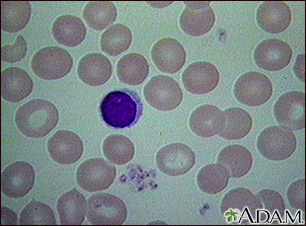

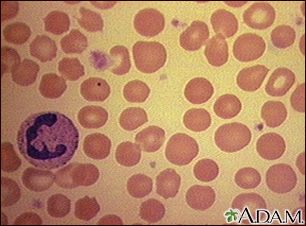







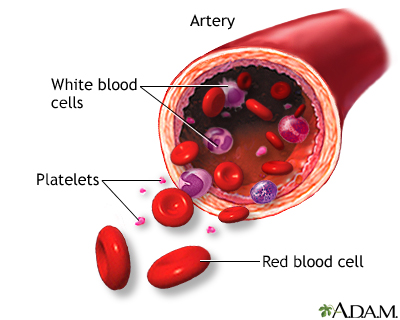


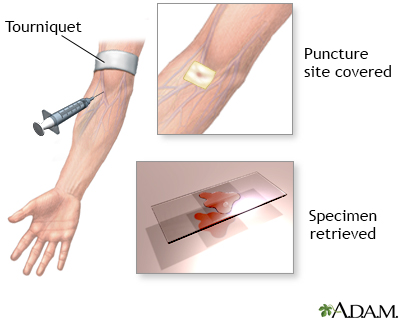
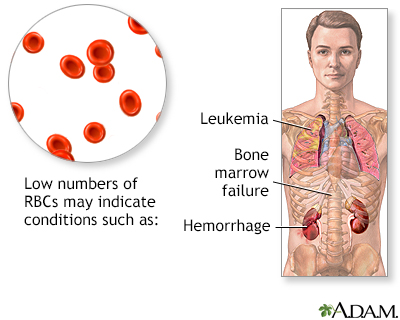
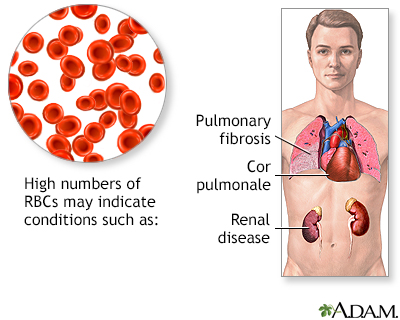
 All rights reserved.
All rights reserved.